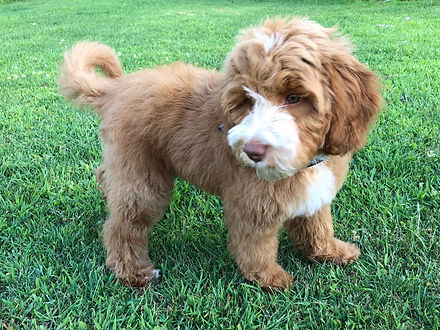


What is an Australian Labradoodle?
The Australian Labradoodle breed dates back to the 1980’s and was initiated with the intent to create a breed that had the temperament of a service dog and was allergy and asthma friendly. During the 1990’s breeders in Australia began breeding Labradoodles to a number of other dog breeds in an effort to produce litters with consistent conformation, coat type, and temperament. Most often the English Cocker Spaniel and American Cocker Spaniel were the breeds used, however, it is reported that a few other dog breeds were also introduced into certain lines. DNA evidence of these dog breeds are still found in a few lines today, while others were bred out and not re-introduced into any other blood lines. Currently the Australian Labradoodle is considered to be a cross between the Poodle, Cocker Spaniel and Labrador Retriever, while the Labradoodle is a cross between the Labrador Retriever and Poodle. This distinction of the breeds and the ALAA’s commitment to the breeds’ health was formally recognized with the creation of the separate breed code Australian Labradoodle by the OFA (the Orthopedic Foundation for Animals).
The Australian Labradoodle is a breed that has been carefully developed since the 1980s, bred over generations with focus on temperament, coat quality and soundness through diligent health testing and planned matings.
-
Australian Labradoodles are multigenerational, meaning both parents of the dog were Australian Labradoodles.
-
No other “doodle” breed has been developed over generations like the Australian Labradoodle.
-
Australian Labradoodles have a consistent appearance and temperament throughout the breed.
-
Australian Labradoodles are people-focused dogs with exceptional eye contact and a desire to please.
Australian Labradoodles have an average life expectancy of 12-15 year.
Currently there are 3 size ranges of the breeds, defined by measuring from the ground to the wither, the highest point on the dog’s shoulder blades.
Miniature: Between 14 and 16 inches (35 to 42 centimeters).
Medium range: Between 17 and 20 inches (43 to 52 centimeters)
Standard range: Between 21 and 24 inches (53 to 63 centimeters).
F1, F1B & MULTIGENERATIONAL
F1: The “F” stands for “filial generation”. “F1” means “first generation” and is a common scientific term. This, in the Labradoodle breed, is the coding for first-cross, purebred Poodle to purebred Labrador Retriever. The results are mixed, as this is not the breeding of two “like” dogs, or dogs that resemble each other. F1 Labradoodles typically are moderate- to low- shedding and have a sparse-hair to fleece coat.
F1B: The additional “B” refers to backcross — an F1 Labradoodle, as defined above, bred (or backcrossed) to a purebred Poodle. Again, the results are mixed, as this is not the breeding of two “like” dogs. F1B Labradoodles typically are low- to non-shedding if both parents non-shedding (or as much as any dog can be non-shedding) and often have a hair or fleece coat.
Multigen Australian Labradoodle (Multigenerational): A Multigen Australian Labradoodle comes about from the breeding of one Australian Labradoodle to another. Multigen Australian Labradoodles typically have a non-shedding coat (as much as a dog can be non-shedding) if both parents are also non-shedding. The AKC requires four generations of like-to-like matings in their foundation service. Once an Australian Labradoodle has been bred to another Australian Labradoodle in four consecutive matings, it will be considered purebred. All of our Australian Labradoodles are multigenerational, 5+ generations and are purebred.
The popularity of the labradoodle has led to a large number of people jumping on the "bandwagon" and attempting to do their own breeding – this practice is resulting in a dog of far lesser quality than most folks would want for a family companion. Inexperienced breeders do not realize that the vast majority of these first generation dogs will shed and still carry many of the other traits that are trying to be avoided in a good-quality Labradoodle. In addition, these inexperienced breeders usually do not take temperament or health testing into consideration. No matter where you get your "doodle", please be careful to assure yourself that you are indeed getting what you want in a dog, especially if you are getting a doodle due to allergies.

